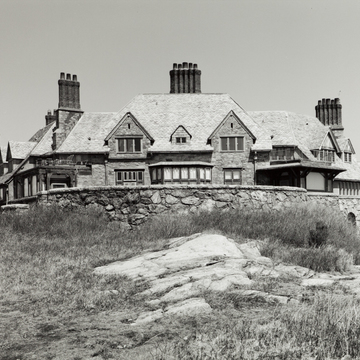You are here
John Russell Pope House (The Waves)
Ledge Road leads to the rocky shore (in the nineteenth century, there was a popular fishing shack here) and to the southern end of the famous Cliff Walk. Its dead end is flanked by two significant houses which suggest the changing character of the landscape as it approaches the more rural Ocean Avenue district. On the east is Edith Wharton's Land's End; and on the west, John Russell Pope's The Waves.
Although now largely obliterated by later changes, the original cottage at Land's End, which John Hubbard Sturgis designed for Samuel G. Ward, was noted for its prominent gambrel- shaped gables and roof forms, reflecting the architect's prescient interest in a colonial revival. It took Sturgis's nephew, Ogden Codman, to make the house memorable, working with Edith Wharton, after she purchased it in 1892, on an addition to the seaside cottage and, most significant, redesigning its interior (not open to the public) after she purchased it in 1892). Its spare arrangement of spaces, with classical details and proportions inspired by French sources, was meant as a corrective to the prevalent ornamental excesses of the generation. It was this project that led Wharton and Codman to collaborate on The Decoration of Houses, published in 1897, heralding a new generation of thinking about interior design.
In designing a seaside retreat for himself and his family, Pope chose a rustic, organic image perfectly in keeping with the rocky, windswept site and its dramatic ocean prospect. The undulating slate roof, heavy timbers, and stone or stucco walls spread around a U-shaped plan underscore in form and materials how tenaciously this house clings to its rugged landscape. Although it is one of the last of the grand houses, The Waves had an unusual distinction in the 1950s after it had passed out of Pope's ownership: it was the first large Newport residence to be divided into condominiums.
Writing Credits
If SAH Archipedia has been useful to you, please consider supporting it.
SAH Archipedia tells the story of the United States through its buildings, landscapes, and cities. This freely available resource empowers the public with authoritative knowledge that deepens their understanding and appreciation of the built environment. But the Society of Architectural Historians, which created SAH Archipedia with University of Virginia Press, needs your support to maintain the high-caliber research, writing, photography, cartography, editing, design, and programming that make SAH Archipedia a trusted online resource available to all who value the history of place, heritage tourism, and learning.





